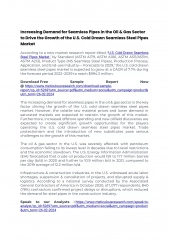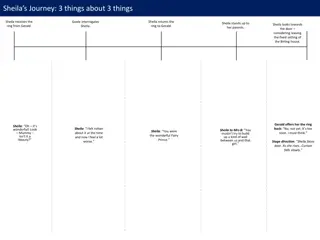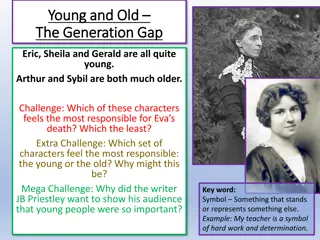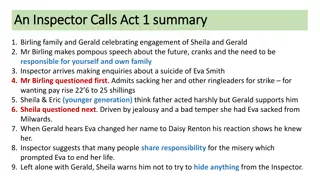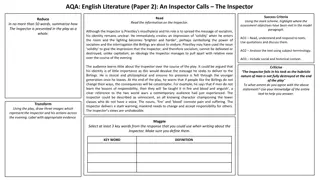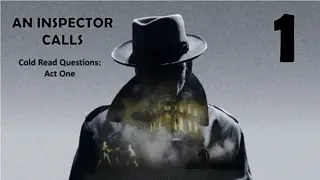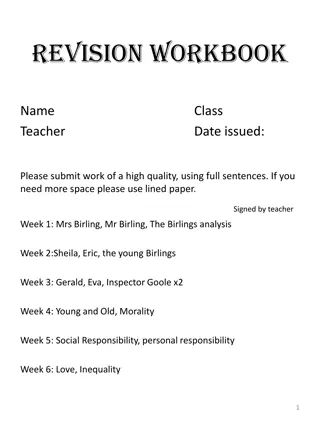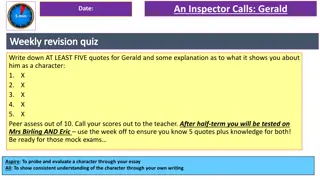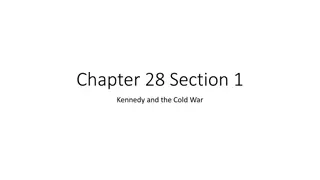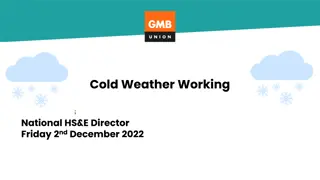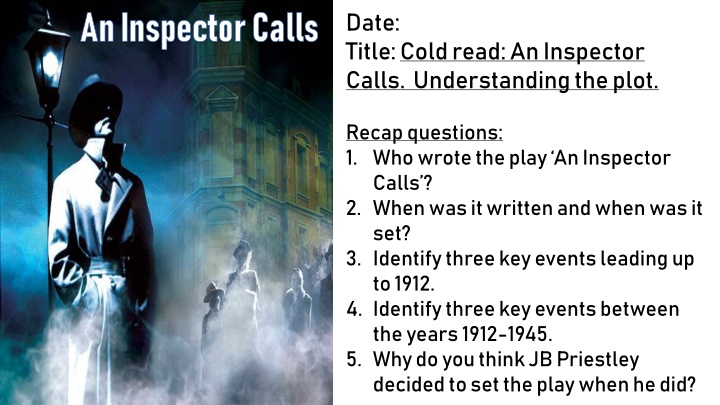
Unveiling "An Inspector Calls" Plot: Key Events and Insights
Delve into the intricacies of JB Priestley's play "An Inspector Calls" with a comprehensive look at the plot, characters, and key events between 1912-1945. Explore the social hierarchy in 1912, the Birlings' middle-class status, and the themes of identity, perspective, culture, transformation, representation, and communication presented in the play.
Download Presentation

Please find below an Image/Link to download the presentation.
The content on the website is provided AS IS for your information and personal use only. It may not be sold, licensed, or shared on other websites without obtaining consent from the author. If you encounter any issues during the download, it is possible that the publisher has removed the file from their server.
You are allowed to download the files provided on this website for personal or commercial use, subject to the condition that they are used lawfully. All files are the property of their respective owners.
The content on the website is provided AS IS for your information and personal use only. It may not be sold, licensed, or shared on other websites without obtaining consent from the author.
E N D
Presentation Transcript
A n Inspector C alls Date: Title: Cold read: An Inspector Calls. Understanding the plot. Recap questions: 1. Who wrote the play An Inspector Calls ? 2. When was it written and when was it set? 3. Identify three key events leading up to 1912. 4. Identify three key events between the years 1912-1945. 5. Why do you think JB Priestley decided to set the play when he did?
Social hierarchy in 1912 New knowledge New knowledge
You have been given the stage directions that appear at the start of the play An Inspector Calls by JB Priestley. The stage directions provide us with a lot of information about the set up at the start of the play. Pen to paper Pen to paper How might we infer from these stage directions that the Birlings are middle class?
The first literary text we are going to study is An Inspector Calls by JB Priestley written in 1945 but set in 1914. It is a play that explores the key concepts of identity (individuals vs collective, gender); perspective (life in 20th century Britain pre and post-war); culture (society during this time, attitudes towards class, power structures); transformation(Priestley s intention mirrored through character transformation); representation (society during this time, class, gender); communication(JB Priestley s intent) Pen to paper As a play, this text was meant to be viewed it is a performance piece so we will start our study of this text by watching an adaptation for the big screen. What we have to bear in mind is that this is an adaptation and is not always as faithful to the text as it should be. 0.00-24.00
As you are watching, I would like you to track the following: Pen to paper 1. Further signs of the Birlings fortunate financial situation 2. The investigation into the death of Eva Smith / Daisy Renton and the line of inquiry for each character in this section Mr Birling. 0.00-24.00
What have we seen? The play begins in a nice dining room, with the prosperous Birling family joyously celebrating the engagement of their daughter, Sheila, to Gerald Croft. Everybody is in good spirits. Mr Birling gives a toast, and Gerald gives Sheila her engagement ring, which she puts on her finger very excitedly. Mr Birling encourages Gerald and Sheila to ignore the pessimistic silly talk going around these days, and claims that fear of an inevitable war is fiddlesticks. New knowledge A Police Inspector arrives, and reports that he is investigating the suicide of a young woman who recently swallowed disinfectant and died in the Infirmary. When he mentions that her name was Eva Smith, Mr Birling identifies that she used to work at his factory, before he forced her to leave when she became the ring-leader of a strike for higher wages. https://www.litcharts.com/lit/an-inspector-calls/summary
Mr Birlings relationship to Eva Smith Pen to paper
As you are watching, I would like you to track the following: Pen to paper 1. Further signs of the Birlings fortunate financial situation 2. The investigation into the death of Eva Smith / Daisy Renton and the line of inquiry for each character in this section Sheila and Gerald 24.00-46.30
What have we seen? Sheila returns to the room, and is very upset to hear about the girl s tragic suicide. The Inspector goes on to tell the family that Eva Smith, after Birling put her out, was hired at a shop Milward s but was fired on the basis of a customer s complaint. When the Inspector shows Sheila a picture of the girl, she begins to sob and runs out of the room. Uponn re-entering, Sheila explains that, out of jealousy and in a bad temper, she had told the manager of Milward s to fire the girl after seeing her smile at a salesgirl when Sheila tried on something unflattering. New knowledge The Inspector then recounts that, after Milwards, the girl changed her name to Daisy Renton, Gerald appears startled by this. When they are left alone for a moment, Sheila discovers that Gerald have been having an affair with Daisy Renton all of the previous summer. When the Inspector returns, Gerald confesses to his acquaintance with Daisy Renton he met her at the Palace Music Hall, and ended up inviting her to live in a set of rooms that belonged to a friend of his who was temporarily away. Gerald excuses himself to take a walk, and Sheila returns his engagement ring. https://www.litcharts.com/lit/an-inspector-calls/summary
Sheila Birlings relationship to Eva Smith Pen to paper
Geralds relationship to Eva Smith Pen to paper
In todays lesson we have learnt about the death of a young woman named Eva Smith / Daisy Renton. We have also learnt that Mr Birling, Sheila Birling and Gerald were all connected to this woman in some way. Reflection Think about these characters actions. How far do you think class plays a part in the treatment of Eva Smith / Daisy Renton?

